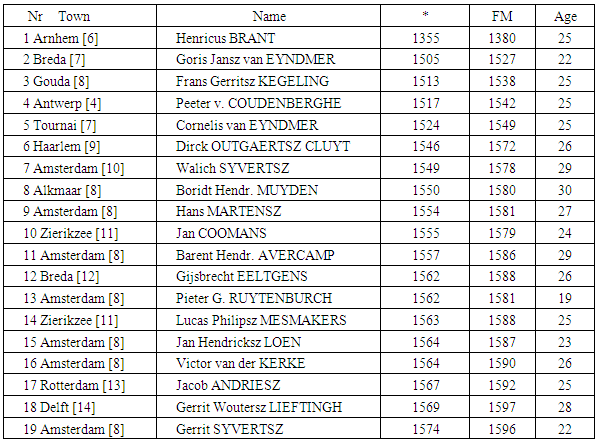-
Paper Information
- Next Paper
- Paper Submission
-
Journal Information
- About This Journal
- Editorial Board
- Current Issue
- Archive
- Author Guidelines
- Contact Us
American Journal of Medicine and Medical Sciences
p-ISSN: 2165-901X e-ISSN: 2165-9036
2015; 5(3): 113-120
doi:10.5923/j.ajmms.20150503.01
Apothecaries in the State of Burgundy. Their Age of Becoming Master and Their Age of Retirement
Nanno Bolt
Society of the History of Pharmacy in Belgium, The Netherlands and Luxembourg, Thury, France
Correspondence to: Nanno Bolt, Society of the History of Pharmacy in Belgium, The Netherlands and Luxembourg, Thury, France.
| Email: |  |
Copyright © 2015 Scientific & Academic Publishing. All Rights Reserved.
In 1477 the State of Burgundy from Charles the Bold included the Low Countries (comprising large parts of present-day Belgium, the Netherlands, Luxembourg and northern France) as well as the duchy of Burgundy and the counties of Nevers and Burgundy. The purpose of this study is to identify the age at which apothecaries obtained their master degree within the territory of the Burgundian State in the 15th and 16th century and the age of retirement as well. From 30 apothecaries their date of birth and/or their date of decease and/or their first and last mention as active apothecary could be identified. The minimum age of a master apothecary within the territory of the Burgundian State during the 15th and 16th century is about 25 years. Master-apothecaries sons were exempted from the apprentice phase, so they started their master career at a (much) younger age. The average age of decease is 59 years for 25 apothecaries identified, but varies strongly. There was no question of retirement, even not for the well-off apothecaries: the year of decease coincide almost always with the year of actively exercising their profession. From 30 identified apothecaries, 6 of them died not naturally, but as a result of manslaughter, execution or pestilence.
Keywords: Master-apothecaries, Burgundian State, Age of obtaining the master-apothecary degree, Age of retirement
Cite this paper: Nanno Bolt, Apothecaries in the State of Burgundy. Their Age of Becoming Master and Their Age of Retirement, American Journal of Medicine and Medical Sciences, Vol. 5 No. 3, 2015, pp. 113-120. doi: 10.5923/j.ajmms.20150503.01.
Article Outline
1. Introduction
- Most studies on the history of mediaeval apothecaries are country-based. But the State of Burgundy included in 1477 (large parts of) Belgium, the Netherlands and France as showed in Figure 1. During the reign of Philip the Good (1419-1467) the administrative cohesion for the territory was strengthened by the foundation and convocation of the States-General in Bruges in 1464. After the Act of Abjuration in 1581 the last link between the Netherlands and Burgundy expired. The purpose of this study is to identify the age at which apothecaries obtained their master degree within the territory of the Burgundian State in the 15th and 16th century and the age of retirement as well.
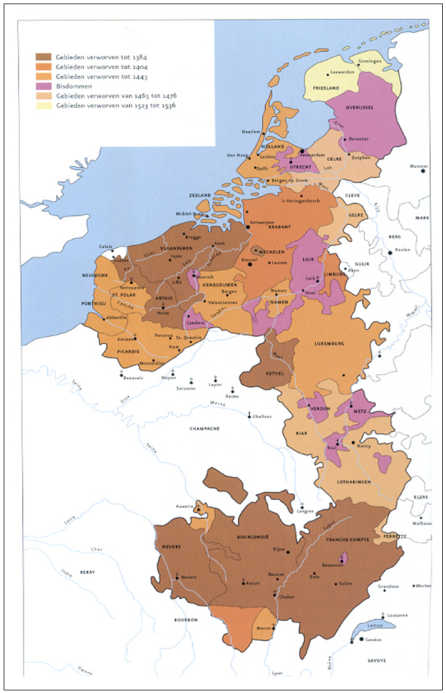 | Figure 1. The Burgundian State between 1384 and 1536 |
2. Methods
2.1. Identification of Apothecaries within the Territory of the Burgundian State
- In the 15te and 16th century a systematic administration of guild members did hardly exist: the first guild administrations origin in general from the end of the 16th century. Identification of apothecaries from the 15th and 16th century has been accomplished based on a wide spectrum of (incidentally) sources, such as appointment agreements between a town-apothecary and the town Magistrate, mentions in deeds of house sale, in heritage arrangements, in account registers from abbeys, churches, noble courts and town councils.A data base has been compiled by the author, based on publications in the Netherlands, Belgium and France containing apothecaries in 77 towns in the State of Burgundy during the 15th and 16th century. See for examples [1] and for the data base of the Low Countries [2].
2.2. Selection of Apothecaries for this Study
- From the 947 apothecaries identified in 77 towns in the State of Burgundy during the 15th and 16th century, those were selected with available data sets for this study: - year of birth & first mention as active apothecary, - year of birth & year of decease- year of decease & year of mention as active apothecary at the end of life.
3. Results
3.1. Co-ordinating Regulations on Apothecary Apprenticeship
- Apothecaries, physicians and town Magistrates saw in general the need to regulate the education of apothecaries at that time. In the towns of Autun and Dijon the apothecaries took the initiative to establish those regulations, in Beaune and Chalon it was the town Magistrate [3]. And at the same time the central authorities played their role like Emperor Charles V with his placard (“Paccaert op‘t stuck der medicyne”) promulgated in 1540 in Brussels [4]. And for the towns in north France the edict of King Charles VIII in 1484 played an important role, establishing the duration of the apothecary apprenticeship (7 years), the inspections of the dispensary and the verification of weights [5].
3.2. The Apothecaries Career Starting Age
- All apothecaries, from which the data set “year of birth & first mention as active apothecary” is known, are represented in Table 1. The average age at a first mention as active apothecary is 25.3 year as showed in Figure 2.
 | Figure 2. Age and average age of 19 starting apothecaries, mainly in the 16th century |
|
3.3. Additional Information on the Apothecaries Mentioned in Table 1
- From most apothecaries mentioned in Table 1 more information is found than just the year of birth & the year of first mention as active apothecary, as pointed out hereafter. Cornelis van Eyndmer, apothecary in Tournai, proceeded against his father, Goris Jansz van Eynmer, apothecary in Breda. In the end they came to an agreement by which the father paid 60 guilders to his eldest son in conformity with his mother’s last will. Peeter van Coudenberghe was born in Brussels on May 16 1517. In 1542 he became citizen of Antwerp and owned a dispensary in the Zilversmidstraat (Silversmithstreet). In 1548 he was the first in the Low Countries to develop a (private) botanical garden with over 600 exotic species. He improved the Dispensatorium of Valerius Cordus (German physician and botanist) with over 400 corrections, published in 1568 by the famous printer Plantin.
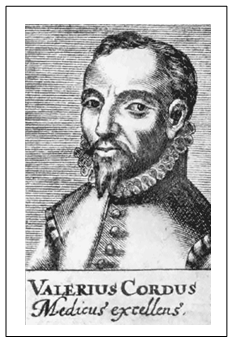 | Figure 3. Valerius Cordus (1515-1544) |
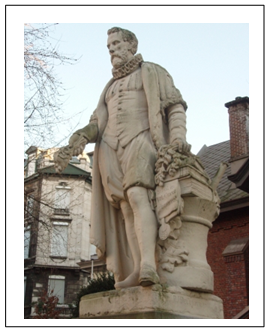 | Figure 4. Peeter van Coudenberghe (1517-1599) |
3.4. The Age at Decease
- All apothecaries, from which the data set “year of birth & year of decease” is known, are represented in Table 2. The average age at decease of the 25 apothecaries is 59,6 year with variations from 37 to 91 year.
|
3.5. The Age of Retirement
- All apothecaries, from which the data set “year at decease & year of mention as active apothecary at the end of life” is known, are represented in Table 3. Table 3 shows that the year of decease coincides nearly always with the year of a last mention as active apothecary, in other words a retirement period was non-existing.
3.6. Additional Information on the Apothecaries Mentioned in Table 3
- The last mentions as active apothecary come from a variety of archive sources as showed hereafter.Master Henricus Brant delivered as court apothecary from 1395 till 1422 to the duchy of Guelders.
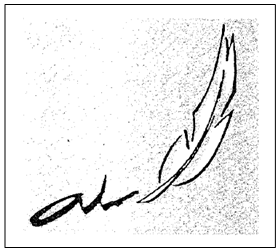 | Figure 5. The ex-libris from Henricus Brant, court-apothecary of the duchy of Guelders |
 | Figure 6. Sealed receipt, dated June 20, 1430 from Jan van Sycleer for delivering medicines to the St.Peter abbey near Ghent. The seal of green wax, with a diameter of 27 mm shows a man with a club and a small lion and has as legend: sigillum Iohannis de syclerus |
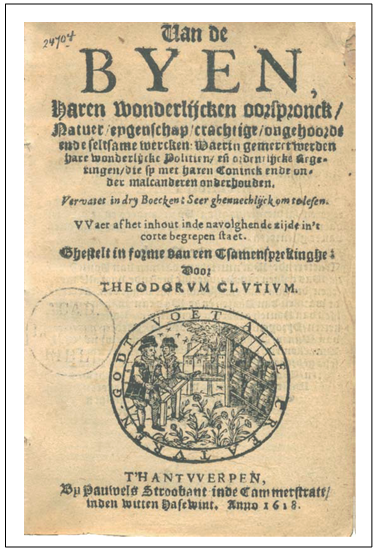 | Figure 7. The vignette on the title page of the reprint from 1618 of Van de Byen matches the text of the booklet, written in the form of a dialogue between two men: Clusius and Clutius |
4. Discussion
4.1. The Age at Decease
- The average age at decease of the 25 apothecaries from Table 2 is 59,6 year with variations from 37 to 91 year. The average life expectancy in the late middle ages is estimated to be 25-27 year. However the infant mortality was extreme high, so older people were not uncommon at all. If we look at the life expectancy once the age of 25 was attained, recent estimations talk about 48 years. The owners of life-annuities in Oudenaarde (East Flanders) – a wealthy group citizens – attainted in the early 16th century the average age of 55-60 year. The apothecaries in the territory of the State of Burgundy belonged as well to the higher middle class, so an average age of 59 years at decease seems not uncommon. [24]
4.2. The Age of Retirement
- Table 3 shows that the year of decease coincides nearly always with the year of a last mention as active apothecary, in other words a retirement period was non-existing. For 6 of the 30 apothecaries considered, it concerned a not natural (sudden) death: manslaughter, execution and pestilence. But even for the wealthy and higher class apothecaries (upper-dean, alderman, burgomaster) no indications are found of a retirement period.
4.3. The Apothecaries Career Starting Age
- The average age at a first mention as active apothecary is 25.3 year and can be considered as the starting age of a apothecary career in the territory of the State of Burgundy during the 15th and 16th century. This age corresponds for instance with the requirements from the Magistrate of Amiens in 1576 for the education of an apothecary: the age at which the formation starts is 14 or 15 year, the apprenticeship should take 4 years and the following master-formation 6 years. After submitting his master work piece, the journeyman is admitted as master-apothecary to the guild at the age of 24-25 year. Master-apothecaries sons were exempted from the apprentice phase, so they started their master career at a (much) younger age. [23]
4.4. Importance of the Apothecaries Education Period
- In order to improve the quality of delivered medicaments (and to eliminate the frequently occurring practices of incompetent people and charlatans), the requirements of the entrance to the apothecary profession became more stringent and were more explicit prescribed in the course of the 15th and 16th century. The apprenticeship started in general at the age of 15 year and the young apprentice was integrated in the household of the apothecary. He should be able to read and write and later on to understand Latin. During the 4 year of apprenticeship the focus was on developing practical skills including the maintenance of balances and weights, the furnace, the distillation units, the jars and pots and on the other hand on developing practical know-how of the simplicia in the apothecaries garden or directly in the nature.Once successfully finished his apprenticeship, the master-servant or journey-man started the second phase of his education, sometimes in the same dispensary, sometimes with another apothecary. After 4 to 6 year he was examined before an examination board of town-physicians, the doyen of the apothecary guild and representatives of the town Magistrate. The examination was split in 3 parts [19]: - the examinee was thoroughly questioned on his know-how of the simplicia and their preparation- on the understanding and interpretation of physician prescriptions- and last but not least the examinee should prepare 3 or 4 composed medicaments during one or more days (the master work piece)After passing his examination, the journeyman was admitted as master-apothecary to the guild at the age of 24-25 year. Master-apothecaries sons were exempted from the apprentice phase, so they started their master career at a (much) younger age. [23]
5. Conclusions
- For the territory of the State of Burgundy during the 15th and 16th century, it was found that the average age at a first mention as active apothecary is 25.3 year, which can be considered as the starting age of a apothecary career. Starting at the age of 15 year, the two phase education took 8-10 year and was required in order to improve and guarantee the quality of the delivered medicaments.From 25 apothecaries identified in this study, the average age at decease is 59 year with variations from 37 to 91 year, not unusual for higher middle class citizens.It was showed that the year of decease nearly always coincides with the year of a last mention as active apothecary, in other words a retirement period was non-existing, even not for the wealthy and higher class apothecaries. For 6 of the 30 apothecaries considered, it concerned a not natural (sudden) death: manslaughter, execution and pestilence.
References
| [1] | N. Bolt, 2014, Pharmacists and their clients in the State of Burgundy., Journal of Pharmacy and Pharmacology, 2 (3), 218-225. |
| [2] | N. Bolt (2014) Data base 3.0 Apothecaries in the Low Countries till 1600. [On line]. Available: http:/www.kringbenelux.eu/wp/?cat=11. |
| [3] | A. Baudot, 1905/2002, La Pharmacie en Bourgogne avant 1803, Dijon, JPM Editions, p.70, 187, 225. |
| [4] | L.J. Vandewiele, 1981, Geschiedenis van de farmacie in België, Beveren, Belgium, Orion, p. 135, 136, 142, 152. |
| [5] | O. Thorel, 1908, Jehan de Louvigny, apothicaire amiénois de 1487-1520, Mémoires de la Société des Antiquaires de Picardie, 1-245. |
| [6] | Ch. De Backer, 1996, Henric Brant, apothecaris te Arnhem, Pharmaceutisch Weekblad, 131 (14), 412,413. |
| [7] | G. Rehm, 1959, De Bredase apothekers van de 15e tot het begin van de 19e eeuw, Bulletin Cercle Benelux d’Histoire de la Pharmacie, 8 (20), 7-10, 17. |
| [8] | A.I. Bierman, M.J. Van Lieberg, D.A. Wittop Koning, 1992, Biografische index van Nederlandse apothekers tot 1867, Rotterdam, Erasmus Publishing. |
| [9] | H.A. Bosman-Jelgersma, 1977, Dirck Outgaertsz Cluyt, Bulletin Cercle Benelux d’Histoire de la Pharmacie, 26 (54), 2. |
| [10] | D.A. Wittop Koning, 1986, Compendium voor de Geschiedenis van de Pharmacie van Nederland, Lochem/ Gent, De Tijdstroom, 189. |
| [11] | C.M. Van Hoorn, 1989, Vijf eeuwen pharmacie in Zierikzee, Bulletin Cercle Benelux d’Histoire de la Pharmacie, 38 (76), 1-9. |
| [12] | A.I. Bierman, 2004, Farmacie in Breda, Bulletin Cercle Benelux d’Histoire de la Pharmacie, 53 (106), 8. |
| [13] | H. Cohen, 1990, De apotheek ”De Vergulde Vijsel” op de Hoogstraat te Rotterdam, Bulletin Cercle Benelux d’Histoire de la Pharmacie, 39 (78), 26. |
| [14] | H.A. Bosman-Jelgersma,1995, Vijf eeuwen Delftse apothekers, Amsterdam, Ronald Meesters, p. 76, 77, 144, 369. |
| [15] | Ch. De Backer, 2002, Mobiliteit en migratie van de apotheker in Vlaanderen en Brabant van de 13e tot de 18e eeuw, Bulletin Cercle Benelux d’Histoire de la Pharmacie, 51 (103), 39. |
| [16] | Ch. De Backer, 1988, Bronnen voor de geschiedenis van de Farmacie te Zutphen, Bulletin Cercle Benelux d’Histoire de la Pharmacie, 37 (74), 23. |
| [17] | Ch. De Backer, 1990, Farmacie te Gent in de late middeleeuwen, Hilversum, Verloren, p. 35-49. |
| [18] | S. Valette, Jehan de Louvigny, apothicaire à Amiens en 1500, Revue d’Histoire de la Pharmacie, 63(227), 551. |
| [19] | H.A. Bosma-Jelgersma, 1983, Poeders, Pillen en Patiënten, Amsterdam, Sijthoff, p. 46, 64. |
| [20] | C. Cabanis, 1987, Les apothicaires et la Réforme, Paris, Fernand Lanore, p. 29. |
| [21] | Ch. De Backer, 2003, Apothekers, geneesheren en chirurgijns, leden van de schuttersgilde Sint-Joris te Aalst tussen 1488 en 1574, Bulletin Cercle Benelux d’Histoire de la Pharmacie, 52 (105), 38. |
| [22] | H.A. Bosman-Jelgersma, 1995, De inventaris van een Leidse apotheek uit het jaar 1587, Bulletin Cercle Benelux d’Histoire de la Pharmacie, 44 (89), 29-33. |
| [23] | N. Sossa, 1939, Histoire de la pharmacie dans la ville d’Amiens, Paris, Librairie Maloine, p. 23, 50. |
| [24] | S. Balace, A. De Poorter, 2010, Tussen hemel en hel. Sterven in de middeleeuwen. Expositie documentatie, Brussel, Mercatorfonds/Koninklijke musea voor kunst en geschiedenis, p. 19, 20. |
 Abstract
Abstract Reference
Reference Full-Text PDF
Full-Text PDF Full-text HTML
Full-text HTML